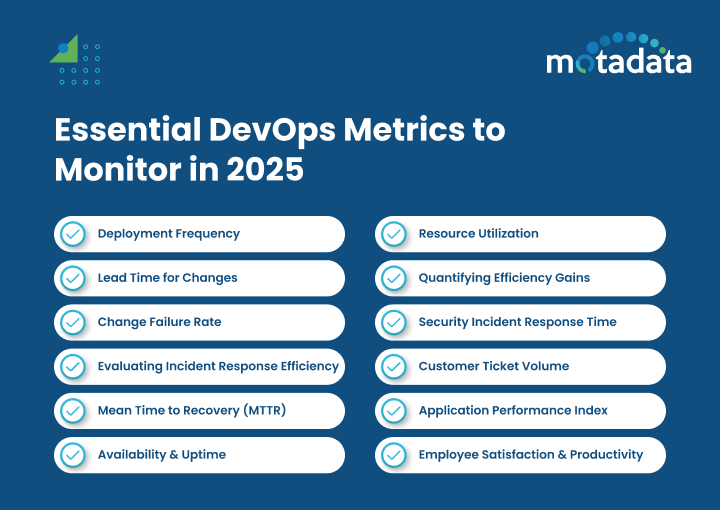DevOps has significantly changed the software development landscape since its implementation by providing real-time insights into system performance and delivering high-quality products.
As of now, companies like Microsoft and IBM that have invested in DevOps techniques have experienced tremendous growth and benefits.
In fact, according to Gartner, by 2025, over 85% of businesses will have a cloud computing strategy in place, and 95% of newly created digital workloads will be carried out on cloud platforms.
As software development and deployment grow more complex, the DevOps metrics landscape is evolving, with sourcing metrics playing a key role in understanding efficiency, ownership, and cost allocation.
With the help of DevOps metrics, businesses are able to track inefficiencies in their software development pipelines, identify areas for improvement, and keep customers satisfied.
There are several benefits to DevOps, but in this blog, we will be paying attention to key DevOps metrics that one must monitor in 2025 to make sure your DevOps procedures are effective and in line with industry best practices.
1. Deployment Frequency
Deployment Frequency is one of the important devops KPIs that help measure how often or quickly code modifications are put into production.
While some DevOps teams may not release changes as frequently as others, the big teams do it multiple times daily, sometimes weekly.
Releasing of code changes to production can completely vary on the project, but it is best to keep everything up-to-date.
So, make sure to measure and track deployment time over a specific period.
This will eventually help keep you updated about the progress of your software delivery process as well as add more value to end users and keep them satisfied.
To improve deployment frequency, you can run automated tests and deployment processes which will reduce manual interventions and human error.
By monitoring testing processes, you can identify issues and work on deployment speed, deployed state, and other issues for quick successful deployment.
Also, you can integrate continuous integration and continuous deployment (CI/CD) pipelines or initiate small and quick updates rather than large releases that happen once a month.
Also, if faults do arise during a deployment, they will also have less of an effect and you will be able to pinpoint the problems with a small deployment more rapidly.
2. Lead Time for Changes
Lead time for changes refers to the duration between when a developer makes a change to the code and when the production team receives that update for use.
The basic idea behind measuring this metric is to get an estimate of how quick your DevOps team can be at producing new features or resolving a problem before it can go into production.
This DevOps metric is highly crucial for resource planning and streamlining procedures.
In order to measure this metric, all you need to do is determine how much time has passed between a change’s commit and production deployment.
Having a lesser lead time implies quick delivery and responsiveness to customer demands. It also represents an effective and streamlined development process.
By reducing lead times, businesses can enhance their time-to-market and customer satisfaction over time.
The best way to achieve this goal is to streamline the CI/CD pipeline and run automated tests to detect issues at an early stage and eliminate bottlenecks.
You can even perform code reviews to get a quick insight into code quality and improve if necessary. Additionally, working with code auditors can help identify security vulnerabilities, ensure compliance, and maintain high-quality standards throughout the development cycle.
3. Change Failure Rate
Another key metric used by DevOps teams to measure the stability of deployments.
It helps track and measure the percentage of changes that failed or resulted in service breaks during the deployment.
A high change failure rate signifies deployments aren’t proceeding as planned which may not be a good sign from a user point of view as well.
A lower charge rate, on the other hand, shows the effectiveness of automated deployment procedures and testing methods, i.e., success rate in implementing changes.
For measuring the change failure rate, just divide the total number of deployments for a certain time period by the number of unsuccessful or failed deployments.
If your change failure rate is above 30%, it is considered to be extremely bad. The best rate that DevOps teams must try to achieve should be 15% or less.
You can conduct thorough testing or perform comprehensive monitoring to identify issues early and keep the change failure rate in control.
Also, deployment automation can be another technique to manage the change failure rate.
4. Time to Restore Service: Evaluating Incident Response Efficiency
With the help of mean time to restore service metrics, team members can assess how quickly abnormalities, bugs, or errors in the production environment can be fixed.
The key is to determine how long it takes your team to bounce back from a setback, whether large or minor and get things back up and running efficiently.
Understanding the effectiveness of incident response and reducing downtime depends heavily on this metric.
The best way to measure this is to track the time when the problem was noticed or found to when it was fully restored.
Businesses should consider utilizing solutions that enable them to identify problems immediately in order to reduce the response time; real-time monitoring and alerts are important examples of such tools.
Shortening downtime is ensured by being prepared before issues arise and having rapid problem-solving skills.
5. Mean Time to Recovery (MTTR)
Mean Time to Recovery (MTTR) is a metric used to quantify how long it typically takes to restore a system or service to normal functioning following an incident or breakdown.
This metric gives a clear idea of how good the team is at responding to issues as they arise.
A system that manages incidents more effectively and responsively, with less downtime and user impact, is said to have a reduced mean time to repair (MTTR). A higher, on the other hand, is not a good sign.
The best way to measure this is to track the time when the problem was noticed or found to when it was fully resolved.
You can improve the mean time to restore service score by performing automated monitoring and using an alert system that instantly responds to detecting issues.
Secondly, run regular incident response drills to fix errors as early as possible and keep the score low for better user experience.
6. Availability and Uptime
A system’s availability and uptime indicate the amount of time your app or service is available and functional.
Ensuring a dependable user experience requires high availability. Using this metric, you can get an idea if there is any issue brewing or if everything is going well within the application.
To ensure everything goes well or improve web security, make sure to invest in a robust infrastructure.
Establish a backup system so that in the event of a malfunction, another component can take over without the outside world noticing.
Furthermore, they have tools that enable them to quickly detect problems and are constantly keeping a close eye on things, allowing them to take action before most people even notice a problem.
You can even leverage load balancers for distributing traffic and avoiding overloading. Another best way to avoid vulnerabilities or downtime is to constantly update and use patch systems.
7. Resource Utilization
The way your operations teams use the servers and network equipment that you have on hand is what’s known as resource utilization.
It’s a crucial DevOps metric that indicates whether or not you’re maximizing your resource usage.
You may tell when something is being overused or underutilized by keeping an eye on this. Efficient use of resources results in reduced expenses and enhanced efficiency.
You can measure this metric simply by investing in performance monitoring tools that give a quick insight into resource utilization.
By implementing auto-scaling features or using containerization and orchestration tools like Kubernetes, you can better manage your resources.
8. Automation Rate: Quantifying Efficiency Gains
The automation rate measures how much of your DevOps processes can run without human involvement.
It identifies tasks previously performed manually that are now automated by computers, accelerating and simplifying operations.
Teams can avoid wasting time on repetitive tasks by implementing automation. Alternatively, they could concentrate on more significant tasks that truly provide value.
This reduces human error rates and expedites the entire software development and delivery process.
The best way to measure the automation rate is to keep track of the proportion of automated versus manual processes.
Businesses should certainly consider prioritizing automation if they want to improve at it.
It’s essential to invest in automation-related products and technology and foster a culture where people are constantly seeking methods to improve operations.
9. Security Incident Response Time: Safeguarding Application Integrity
The key to achieving a fast security incident response time is being able to identify and address vulnerabilities or security flaws in your systems or applications.
It demonstrates how effectively your group resolves these issues and whether your safety precautions are adequate.
Maintaining the security of your apps and safeguarding sensitive data requires prompt detection and resolution of security issues. You’re doing a great job of staying secure if you’re quick at this.
You can measure it by maintaining a record of how long it took from detecting a security incident to resolving it.
To improve this rate, companies must closely monitor any security risks or warning signs, adhere to best practices for managing software failures effectively, and regularly test and upgrade if they want to improve their ability to react swiftly.
Quick action in the event of an issue reduces potential attack damage and increases system security.
This provides protection from any potential threats in addition to ensuring that apps operate without delays.
10. Customer Ticket Volume
In customer support and service management, Customer Ticket Volume is a crucial metric that counts the number of requests or issues that customers have throughout a specific time frame.
This figure is essential for estimating the workload of customer service representatives and evaluating user satisfaction.
The best way to measure it is by counting how many support tickets customers submit during specific periods.
A high volume of customer tickets typically indicates dissatisfaction or a problem with your product or service.
Monitoring these ticket volumes helps you identify areas that need improvement, understand customer feedback, and prioritize bug fixes accordingly.
To keep the count low, you must perform usability tests on a regular basis to detect and resolve issues faster.
Secondly, you must work on improving your self-service resources or documentation for quick resolutions.
Further, implementing proactive monitoring practices can also be beneficial as it will help identify and resolve tickets before they impact users.
11. Application Performance Index (Apdex): Scoring User Experience
The Application Performance Index (Apdex) measures how well users utilize your application or service. It offers a uniform approach to measuring the user experience.
You can calculate this figure by dividing the total number of response times by the number of satisfactory response times. A perfect user experience is represented by a score of 1, which goes from 0 to 1.
For scoring a good Application Performance Index (Apdex), businesses must invest in monitoring tools that help optimize application performance.
Also, you can use performance analytics to identify errors and determine reasonable organization’s performance goals based on what different people expect.
12. Employee Satisfaction and Productivity
Monitoring the satisfaction and productivity of your development teams is crucial.
When employees are happy in their roles, they are more likely to produce high-quality software, work more efficiently, and have better ideas.
You can question your team members directly through surveys or chats, and you can maintain continuous communication to find out if they are happy with their work.
In this manner, you’ll be aware of what’s functioning effectively and what needs a little more care to improve everyone’s day-to-day interpersonal and teamwork skills.
By creating a warm atmosphere where people can advance their careers and receive recognition for their achievements, and by conducting an employee perception survey to track ongoing sentiment, you can make sure that your development teams are successful in terms of both satisfaction and output.
Conclusion
Monitoring DevOps metrics is essential to streamlining processes and achieving optimal performance.
Businesses may improve the effectiveness and reliability of their software development work by keeping an eye on critical indicators like the frequency of deployments, the time it takes to make changes, and the average amount of time it takes to resolve problems.
Further, other metrics include Mean Time to Recovery (MTTR), availability and uptime, resource utilization, Application Performance Index (Apdex), customer ticket volume, and more.
Monitoring any of the aforementioned metrics aims to increase productivity and enhance delivery.
When starting to scale DevOps, the four DORA metrics are an excellent place to start, while there’s no hard and fast rule about which specific metrics you should track.
By focusing on these metrics, businesses may further improve their adaptability, efficiency, and capacity to provide value to their users.
In the coming period, experts anticipate developments in automation, artificial intelligence (AI)-driven insights, and real-time monitoring.
These developments will increase the tracking and optimization of DevOps metrics even further, promoting operational excellence and continuous improvement.
However, for now, implement effective monitoring practices to refine your strategy or adopt the powerful tools and practices that offer more value to your users.
FAQs:
One of the major reasons why DevOps metrics are crucial is it helps support teams in making the right decisions by gaining quick insights into the performance of systems and pointing out areas for improvement.
With the help of DevOps metrics, businesses can identify and remove any bottlenecks in the devops process before they impact users.
These metrics are necessary to guarantee the timely, reliable, and high-quality delivery of software.
You should review DevOps metrics periodically, preferably daily or weekly, to enable prompt issue diagnosis and continuous improvement.
The goals and requirements of your business will determine how frequently you should verify these indicators, but it’s a good idea to review them at least once a month or every few months.
By using this strategy, firms may adapt quickly and change their development processes as needed to achieve ongoing progress.
Companies that regularly review these metrics are better able to assess their progress, identify areas for improvement, and make decisions grounded on data that supports continuous improvement.
Real-time monitoring, AI-driven insights, greater automation, and a stronger emphasis on security and user experience metrics are some of the upcoming trends in DevOps analytics.
A culture of proactive problem-solving and continuous improvement should be promoted.
Further, you must automate the process of data collection and analysis as well as set clear key performance indicators (KPIs).
Additionally, adopt thorough monitoring technologies to ensure effective monitoring of DevOps metrics.







